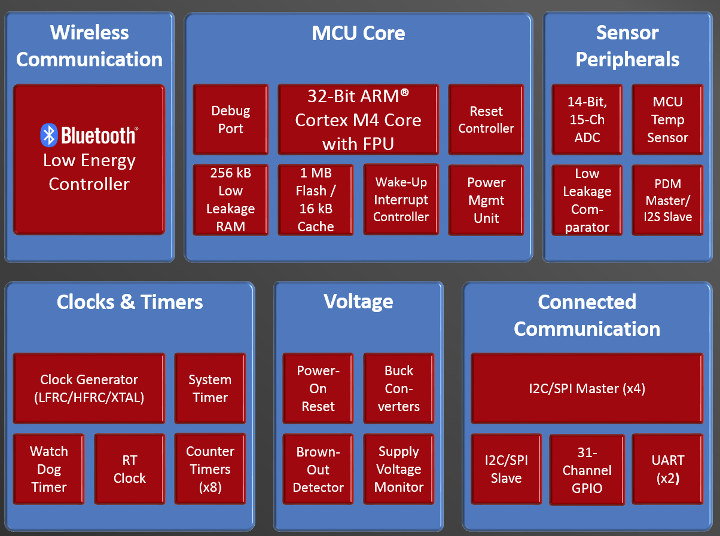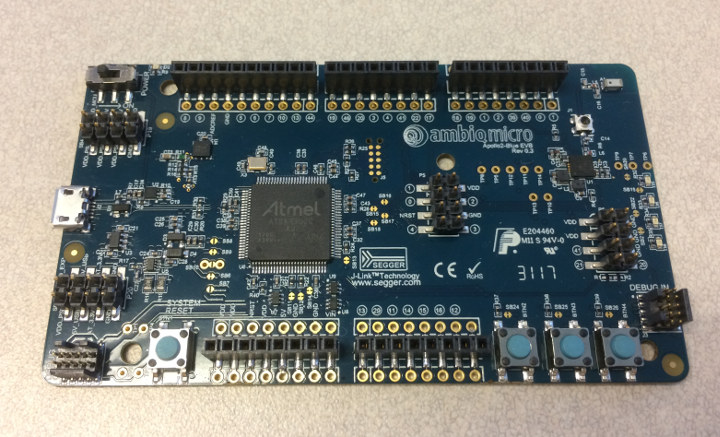Ambiq Micro unveiled their ultra-low power Apollo MCU back in 2015 with claims of Cortex-M4 performance at Cortex-M0+ energy efficiency by leveraging SPOT (Subthreshold Power Optimized Technology) technology that allows operating the microcontroller at very low voltages (less than 0.5V). Since then the company introduced Apollo2 MCU with 10 μA/MHz power consumption, but still a generic purpose microcontroller.
Earlier this year, the company unveiled a new version of Apollo2 microcontroller adding Bluetooth connectivity, and allowing Bluetooth applications that last years on a charge. Meet Apollo2 Blue.

Apollo2 Blue key features and specifications:
- Arm Cortex-M4 Processor up to 48 MHz with FPU, MMU, wake-up interrupt controller with 32 interrupts
- Ultra-low power memory
- Up to 1 MB of flash memory for code/data
- Up to 256 KB of low leakage RAM for code/data
- 16kB 1 or 2-way Associative Cache
- Bluetooth 5 Low Energy
- RF sensitivity – -95 dBm
- TX: 5mA @0 dBm; RX: 3.5mA
- Tx output power: -40 dBm to +5 dBm
- AES 128-bit encryption
- Over-The-Air updates (OTA)
- Coexistence with other 2.4 GHz wireless
- Bluetooth SIG profiles support
- Enhanced data rate up to 2 Mbps
- Built in 32 KHz RCO
- Ultra-low power interface for off-chip sensors
- 14-bit, 15-channel, up to 1.2 MS/s ADC
- Selectable 8/10/12/14 bit precision to save energy
- Voltage comparator
- Temperature sensor with +/-2ºC accuracy
- Serial peripherals – 4x I2C/SPI master, 1x I2C/SPI slave, 2x UART, PDM for mono and stereo audio microphone, I2S slave for PDM audio pass-through
- Configurable timing peripherals
- RTC with both 32.768 kHz XTAL and 1.024 kHz RC sources
- 8x 16-bit timers with flexible functionality for timing and PWM generation
- 32-bit system timer with 8 compare registers for interrupt generation and 4 capture registers
- Clock sources
- 32.768 kHz XTAL oscillator
- Low frequency RC oscillator – 1.024 kHz
- High frequency RC oscillator – 48 MHz
- RTC based on Ambiq’s AM08X5/18X5 families
- Ultra-low supply current (Bluetooth in shutdown)
- <10 μA/MHz executing from flash at 3.3 V
- <10 μA/MHz executing from RAM at 3.3 V
- < 3 μA deep sleep mode with RTC at 3.3 V
- Wide operating range – 1.755-3.6 V, –40 to 85°C
- Package – 4 x 4 x 0.9mm 64-pin LGA
On the software side, the company provides FreeRTOS 9.0, Arm Cordio BLE stack (WiCentric), proprietary OTA firmware update method, fitness & watch profiles, standard Bluetooth SIG LE profiles, Tx Power control, and more. Supported toolchains include IAR, Keil, GCC and Segger.

The company also offers Apollo2 Blue EVB for development with Arduino headers. The Atmel processor is used for debugging purpose. and if you are looking for Apollo2 Blue MCU it’s the small black chip in the top right corner area. You’ll find more details about the MCU and development kit including datasheet, schematics, PCB layout, and getting started guide on the product page.
Typical applications would include any battery powered device requiring Bluetooth connectivity such as smart watches, wireless sensors, activity and fitness trackers. home automation, wireless mice and keyboards, alarms and security system, and others.
Ambiq Apollo2 Blue evaluation board can be purchased for 70 Euros + VAT + shipping on Fujitsu webstore, while sample price for the chip itself is 2.98 Euros.

Jean-Luc started CNX Software in 2010 as a part-time endeavor, before quitting his job as a software engineering manager, and starting to write daily news, and reviews full time later in 2011.
Support CNX Software! Donate via cryptocurrencies, become a Patron on Patreon, or purchase goods on Amazon or Aliexpress





So they gave up on the sub threshold logic and moved to an Off the Shelf ARM core? That’s dissapointing.
You might want to re-read the first few sentences. They’re using their technology on ARM cores to make them more power efficient. Same with their previous products.
Not sure, the voltage range is said to be 1.7-3.6V here.
The input voltage not the core voltage
Deets is right, the Apollo MCU announced in 2015 has a similar voltage range: 1.8 to 3.8V. ~0.5V is only the core voltage.
That’s not how I parse those sentences. CNXsoft, is that your intended meaning? Is this an ARM core implemented in sub-threshold logic?
The way I parsed it was that they came out with a STL chip in the past and later came out with a second generation, but now they’re coming out with an ARM based chip (no implication of it being STL).
If this really is an ARM core in STL, then that’s wonderful.
They’re based out of Texas, I’ll just call them after the weekend and ask directly.
Well, I give up, I’ve tried calling four times in the last two days and I can’t get a human being on the line. They don’t even have an IVR, it’s just a simple answering machine.